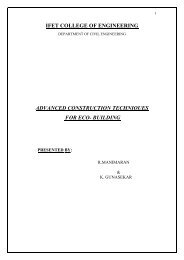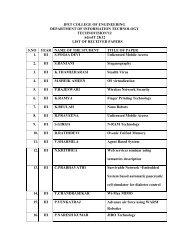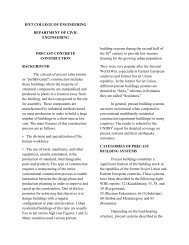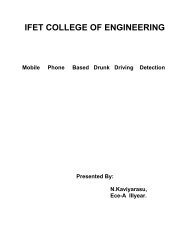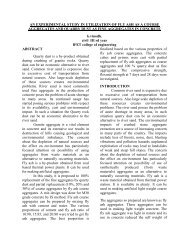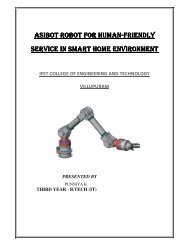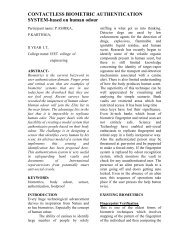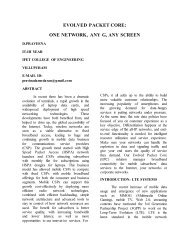IMOD Screens - Low Power Display Technology with MEMS
IMOD Screens - Low Power Display Technology with MEMS
IMOD Screens - Low Power Display Technology with MEMS
- No tags were found...
Create successful ePaper yourself
Turn your PDF publications into a flip-book with our unique Google optimized e-Paper software.
<strong>IMOD</strong> <strong>Screens</strong> - <strong>Low</strong> <strong>Power</strong> <strong>Display</strong><strong>Technology</strong> <strong>with</strong> <strong>MEMS</strong>It is an application of Nano-technologyPresented byG.Mimal arthiB TECH IT 2 nd yearIFET college of engineeringmimalganesh@gmail.comcontact no:9486168636S.GayathriB TECH IT 2 nd yearIFET college of engineeringprinceg3.eg@gmail.comcontact no:8754125267
1.1.working principle: The basic elements of an <strong>IMOD</strong>baseddisplay are microscopicdevices that act essentially as mirrorsthat can be switched on or offindividually. Each of these elementsreflects only one exact wavelength oflight (such as a specific hue of red,green or blue) when turned on, andabsorb light (appear black) when off.Elements are organised into arectangular array in order to producea display screen An array of elements that all reflectthe same color when turned onproduces a monochromatic display,for example black and red (in thisexample using <strong>IMOD</strong> elements thatreflect red light when "on"). As eachelement reflects only a certainamount of light, grouping severalelements of the same color togetheras subpixels allows differentbrightness levels for a pixel based onhow many elements are reflective ata particular time. Multiple color displays are createdby using subpixels, each designed toreflect a specific different color.Multiple elements of each color aregenerally used to both give morecombinations of displayable color(by mixing the reflected colors) andto balance the overall brightness ofthe pixel. Because elements only use power inorder to switch between on and offstates (no power is needed to reflector absorb light hitting the displayonce the element is either reflectingor absorbing), <strong>IMOD</strong>-based displayspotentially use much less power thandisplays that generate light and/orneed constant power to keep pixelsin a particular state. Being areflective display, they require anexternal light source (such asdaylight or a lamp) to be readable,just like paper or other electronicpaper technologies.2.<strong>IMOD</strong> <strong>Display</strong> <strong>Technology</strong>:Working prototypes of low-poweredinterferometric modulation screens werefirst unveiled at CES 2010. It is believedthat Qualcomm's Mirasol <strong>IMOD</strong> displayswill succeed the monochromatic "E-Ink"screens that presently dominate the e-readerindustry.The <strong>IMOD</strong> display uses just 1 mW whereasan ebook size TFT LCD screen needs up to10 W of power. This is mainly because the<strong>IMOD</strong> does not need a backlight forviewing. The <strong>IMOD</strong> can be easily viewed indirect sunlight as it uses the surroundinglight instead of a backlight for illumination.<strong>IMOD</strong> displays can handle videos at arefresh rate of up to 15 fps. Though this maynot be ideal for high-quality video, theswitching speed is sufficient to make thedisplay video capable, <strong>with</strong> no motion-blureffects.
Fig 2.1includes a deformable reflective membrane,which is self-supporting and a thin-filmstack, each of which behave as a singlemirror of an optically resonant cavity <strong>with</strong>both residing on a transparent substrate.Striking of ambient light on the structurecauses it to be reflected both off the top ofthe thin-film stack and also off the reflectivemembrane.3.How Do <strong>IMOD</strong> <strong>Display</strong>s Work?The Mirasol display from Qualcomm is thefirst in the industry to use interferometricmodulation (<strong>IMOD</strong>).The <strong>IMOD</strong> element, which is the corebuilding block of Mirasol displaytechnology includes two stable states. Whenthere is no voltage, separation of the platesoccurs and the light striking the substrate isreflected. On application of a small voltage,electrostatic attraction pulls the platestogether and light is absorbed, causing theelement to turn black. This bistable nature iskey to mirasol display’s excellent energyefficiency.Fig 3.2Fig 3.1Basically, a pixel in a Mirasol display is anoptically resonant cavity. The deviceBased on the optical cavity height, light ofspecific wavelengths that bounce off themembrane will be slightly out-of-phase <strong>with</strong>the light that reflects off the thin-film
structure. Some wavelengths constructivelyinterfere and some destructively based onthe phase difference. A color is perceived bythe human eye as certain wavelengths willbe magnified <strong>with</strong> respect to others. Themirasol display image is capable ofswitching between black and the selectedcolor by changing the state of themembrane. This is achieved by theapplication of voltage to an electricallyconducting thin film stack protected by aninsulating layer. The application of voltagethat results in electrostatic forces causescollapse of the membrane. The change in theoptical cavity causes constructiveinterference at ultraviolet wavelengths,which cannot be seen by the human eye.Hence the image seen on the screen looksblack. The <strong>IMOD</strong> elements that reflect in theRGB wavelengths are spatially ordered andassembled to form a full-color display.4.Pixel Information:A pixel in an <strong>IMOD</strong>-based display consistsof one or moresubpixels that are individualmicroscopic interferometric cavities similarin operation to Fabry–Pérotinterferometers (etalons), and the scalesin butterfly wings. While a simple etalonconsists of two half-silvered mirrors, an<strong>IMOD</strong> comprises a reflective membranewhich can move in relation to asemitransparent thin film stack. With an airgap defined <strong>with</strong>in this cavity, the <strong>IMOD</strong>behaves like an optically resonant structurewhose reflected color is determined by thesize of the airgap. Application of a voltageto the <strong>IMOD</strong> creates electrostatic forceswhich bring the membrane into contact <strong>with</strong>the thin film stack. When this happens thebehavior of the <strong>IMOD</strong> changes to that of aninduced absorber. The consequence is thatalmost all incident light is absorbed and nocolors are reflected. It is this binaryoperation that is the basis for the <strong>IMOD</strong>'sapplication in reflective flat panel displays.Since the display utilizes light from ambientsources, the display's brightness increases inhigh ambient environments (i.e. sunlight).In contrast, a back-lit LCD display suffersfrom incident light.Fig 3.3
For a practical RGB color model (RGB)display, a single RGB pixel is built fromseveral subpixels, because the brightness ofa monochromatic pixel is not adjusted.Fig 4.1A monochromatic array of subpixelsrepresents different brightness levels foreach color, and for each pixel, there arethree such arrays: red, green and blue.5.Competing <strong>Display</strong> Technologies:The use of OLEDs in displays has beenrestricted by the cost and scalability ofproduction for large screens, althoughOLED remains a significant competitor inthe smartphone display market.Carbon nanotube-based displays have alsobeen investigated. Since the chemical natureof carbon nanotubes (CNTs) is quitedifferent to other carbon forms, the toxicityFig 4.2of CNTs must be studied carefully. CNTsynthesis is challenging to control, making itquite expensive. Furthermore, CNTprocessing for displays need uniformdispersion and CNT mats result in materialwastage.Reports suggests that Qualcomm will beinvesting around $120 million to obtain a5% stake in struggling consumer electronicsand liquid crystal display manufacturerSharp. The proposed equity investment will
e utilized for the expansion of a contractbetween Qualcomm subsidiary Pixtronixand Sharp for the development andcommercialization of <strong>MEMS</strong>-based displaysthat can be manufactured <strong>with</strong> Sharp LCDproduction lines.already demonstrated reflectivities of morethan 80 percent using Digital Papertechnology, and that contrast ratios of 12:1,viewing angles of ±60 deg., and drivevoltages
the color reflected when the two surfaces areseparated (left), the designer must calculatethe additional distance required and set theheight of the membrane accordingly.The IMods, on the other hand, useinterference in a way that has much more incommon <strong>with</strong> reflection holography (Figure1). The device consists of a conductingmetallic membrane, a thin-film stackprotected by an insulating layer, and atransparent substrate (in this case, glass).The stack and metal membrane act as twomirrors in an optical resonator. The opticaldistance between them determines whichwavelengths constructively interfere <strong>with</strong>each other -- and so are reflected by thedevice -- and which destructively interfereand are absorbed.Where no current is flowing, the opticaldistance between the two mirrors isdetermined by the thickness and refractiveindex of the insulator, and the height of themembrane. When the device is switched,however, the current causes the membraneto be electrostatically attracted to theinsulator, stack, and substrate. When itmakes contact, the optical distance drops tothat through the insulator, and the colorchanges. By using this method, some of theproblems inherent to diffractive systems areimmediately solved. In particular, there isalmost no "rainbow effect," where the colorchanges <strong>with</strong> viewing angle.2004, and subsequently formed Qualcomm<strong>MEMS</strong> Technologies(QMT). Qualcomm has allowedcommercialization of the technology underthe trademark name "mirasol", and thisenergy-efficient, biomimetic technologysees application and use in portableelectronics such as e-bookreaders and mobile phonesThe restoration force of the membrane islinear whereas the electrostatic forceopposing it is nonlinear. As a result, if thevoltage is kept at the correct level (here,somewhere between 3 and 5 V) the deviceonly needs to be switched when its state isactually required to change; it will thenmaintain that state until it is switched again.This bistable operation means that thedevice has inherently low powerrequirements.Iridigm has produced a number of differenttest displays using their first-generationdesign, including a Palm-Pilot-sized screen.In these systems, tens or hundreds of 40- X30-µm IMods were used <strong>with</strong>in eachpixel.Though most of the demonstrations sofar have been monochromatic, the companysays that, using conventional RGB additivecolor mixing, full-color displays are astraightforward extension of the existingtechnology.6.Development Of <strong>IMOD</strong>:The <strong>IMOD</strong> technology was invented byMark W. Miles, a <strong>MEMS</strong> researcher andfounder of Etalon, Inc., and (co-founder) ofIridigm <strong>Display</strong> Corporation. Qualcommtook over the development of thistechnology after its acquisition of Iridigm inFigure 3. The second-generation IMod supportsa large membrane on posts, giving a fill-factorof 95 percent.Among the improvements that Iridigm hasbeen working on is its second-generationdesign (Figure 3), which has already been
fabricated and tested. Here, a largemembrane is raised up using a number ofsupport posts, rather than having lots ofsmall, separate devices. The new design notonly supports a fill factor of up to 95percent, but it has also has good long-termbehavior. In tests, it has been shown to bereliable for a number of switch cyclesequivalent to using a Palm Pilot four hours aday for 18 years.mp3 applications from FreestyleAudio and Skullcandy.In the mobile phone marketplace,Taiwanesemanufacturers Inventec and Cal-Comp have announcedphones <strong>with</strong> mirasol displays,and LG claims to be developing "oneor more" handsets using mirasoltechnology.These products all have only twocolor(black plus one other) "bichromic"displays.7.Uses of <strong>IMOD</strong>: Future <strong>IMOD</strong> panels manufacturersinclude, Qualcomm in conjunction<strong>with</strong> Foxlink, having establisheda joint-venture <strong>with</strong> Sollink in 2009<strong>with</strong> a future facility dedicated tomanufacturing <strong>IMOD</strong> panels.Production for this began in Jan2011, <strong>with</strong> the fabricated panelsintended for devices such as e-readers8.Advantages of <strong>IMOD</strong><strong>Display</strong>s (Mirasol)Bistability:This nature inspired <strong>MEMS</strong>-basedinnovation is bistable. This allows nearzeropower usage in situations where thedisplay image is unchanged. Thisbistability derived from the inherenthysteresis of the material causesconsiderable power savings, especiallycompared to displays that continuallyrefresh, such as LCDs. [3, 4]Speed: <strong>IMOD</strong> displays are now available inthe commercial marketplace QMT's displays, using <strong>IMOD</strong>technology, are found in theAcoustic Research ARWH1Stereo Bluetooth headset device. the Showcare Monitoring system(Korea), theHisense C108Since visible light wavelengths lie inthe nanometer scale (i.e. 380nm to780nm), the deformable <strong>IMOD</strong>membrane only has to move a shortdistance (~100nm) in order to switchbetween two colors. This switchinghappens extremely fast, on the orderof tens of microseconds. [2] This is1000 times faster than that oftraditional displays. Higherswitching speed directly translates toa video rate-capable display <strong>with</strong> nomotion-blur effects. [4]
Robustness:In addition to microsecondswitching, mirasol displays maintaintheir switching speed across a widetemperature range. In contrast, theswitching speeds of organic liquidcrystal-baseddisplays decrease astemperatures go into lowenvironmental ranges. [1, 4]Readability:A mirasol display offers a superiorcontrast ratio in brightly litenvironments. Qualcomm's mirasoldisplays offer reflectivity on theorder of 60 percent and contrastratios greater than 10:1. Bycomparison, the Wall Street Journalnewspaper offers a reflectivity of 60percent and a contrast ratio of around4:1Reflective technology based onbio-mimetic models hold muchpromise. for commercial use,reflective displays they need to beviewed in both daylight and in thedark. The commercialization of thistechnology is thus dependent oncombining the benefits of backlittransmissive displays <strong>with</strong> theoutdoor readability of reflectivetechnologies9.Conclusion:<strong>IMOD</strong> display technology is developingrapidly, and is expected to soon becomedominant in displays for low-power,portable applications like e-readers, remoteequipment for military applications, andperhaps in products aimed at third worldcountries such as OLPC. The advantages of<strong>IMOD</strong> displays are that they require verylittle power, feature excellent viewabilityeven in bright sunlight, high readability,robust functionality, technical flexibility andmechanical durability.. [1, 2, 3] These newdisplays will mean faster response times,better color reproduction, and higherresolutions - a revolution in displaytechnology.References:1. M.W. Miles, Digital Paper: Reflective<strong>Display</strong>s Using Interferometric Modulation,SID Digest 5.3, 2000.2. Sunny Bains, Grating Light Valve speedexploited in new architecture, OE Reports,August 1998.Sunny BainsSunny Bains is a scientist and writer basedin London, UK. [3] J. B Sampsell, "<strong>MEMS</strong>-Based <strong>Display</strong> <strong>Technology</strong> Drives Next-Generation FPDs for Mobile Applications,"Information <strong>Display</strong> 22, No. 6, 24 (2006).[4] C.-D. Liao, "The Evolution of <strong>MEMS</strong><strong>Display</strong>s," IEEE Trans. IndustrialElectronics 56, 1057 (2009).




